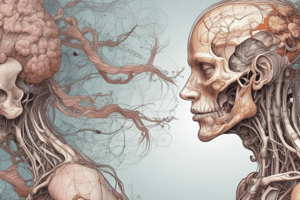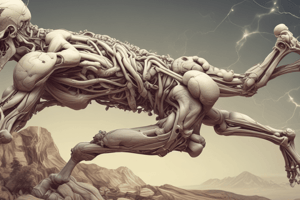Podcast
Questions and Answers
What is the primary function of reticular connective tissue?
What is the primary function of reticular connective tissue?
- Provides flexibility to joints
- Stores fat in adipose tissue
- Separates different types of muscle tissue
- Forms a supportive framework for certain organs (correct)
What happens to TRH levels when thyroid hormone levels are high?
What happens to TRH levels when thyroid hormone levels are high?
- TRH levels fluctuate
- TRH levels remain unchanged
- TRH levels increase
- TRH levels decrease (correct)
Which type of cartilage is primarily responsible for providing smooth surfaces for joint movement?
Which type of cartilage is primarily responsible for providing smooth surfaces for joint movement?
- Fibrocartilage
- Hyaline Cartilage (correct)
- Articular Cartilage
- Elastic Cartilage
What is the study of how the body maintains homeostasis primarily focused on?
What is the study of how the body maintains homeostasis primarily focused on?
Which of the following is an example of positive feedback?
Which of the following is an example of positive feedback?
Where is elastic cartilage typically found?
Where is elastic cartilage typically found?
What type of cells are chondrocytes found in?
What type of cells are chondrocytes found in?
What is the anatomical position?
What is the anatomical position?
Which of the following levels of organization describes a collection of similar cells working together?
Which of the following levels of organization describes a collection of similar cells working together?
In which plane does a horizontal cut dividing the superior and inferior portions of the body occur?
In which plane does a horizontal cut dividing the superior and inferior portions of the body occur?
What characterizes compact bone tissue?
What characterizes compact bone tissue?
Which body system is NOT categorized under Infrastructure according to the provided content?
Which body system is NOT categorized under Infrastructure according to the provided content?
What provides the rigidity and strength of bone tissue?
What provides the rigidity and strength of bone tissue?
Which of the following describes the supine position?
Which of the following describes the supine position?
What is the primary function of spongy bone?
What is the primary function of spongy bone?
What is the primary function of negative feedback mechanisms?
What is the primary function of negative feedback mechanisms?
Which of the following is an essential characteristic of life that involves sensing changes in the environment?
Which of the following is an essential characteristic of life that involves sensing changes in the environment?
What type of membrane lines cavities that open to the outside of the body?
What type of membrane lines cavities that open to the outside of the body?
Where is spongy bone primarily located?
Where is spongy bone primarily located?
Which type of connective tissue is mainly involved in immune functions and blood cell development?
Which type of connective tissue is mainly involved in immune functions and blood cell development?
What mechanism is activated when body temperature rises, according to the feedback mechanisms described?
What mechanism is activated when body temperature rises, according to the feedback mechanisms described?
Which component of blood is primarily responsible for oxygen transport?
Which component of blood is primarily responsible for oxygen transport?
Which function is associated with fibrocartilage?
Which function is associated with fibrocartilage?
What component is responsible for detecting stimuli in a feedback loop?
What component is responsible for detecting stimuli in a feedback loop?
What role do platelets play in the bloodstream?
What role do platelets play in the bloodstream?
The appendicular region of the body primarily includes which parts?
The appendicular region of the body primarily includes which parts?
Which of the following statements regarding organ systems is incorrect?
Which of the following statements regarding organ systems is incorrect?
Which level of structural and functional organization includes atoms and molecules interacting?
Which level of structural and functional organization includes atoms and molecules interacting?
What is a characteristic feature of skeletal muscle tissue?
What is a characteristic feature of skeletal muscle tissue?
Which of the following best describes blood's matrix?
Which of the following best describes blood's matrix?
What is the voluntary muscle tissue responsible for body movement?
What is the voluntary muscle tissue responsible for body movement?
Which type of connective tissue helps regulate body temperature?
Which type of connective tissue helps regulate body temperature?
What is the primary function of skeletal muscle?
What is the primary function of skeletal muscle?
Where is cardiac muscle specifically located?
Where is cardiac muscle specifically located?
Which characteristic is unique to cardiac muscle fibers?
Which characteristic is unique to cardiac muscle fibers?
What function does smooth muscle serve in the body?
What function does smooth muscle serve in the body?
What type of muscle is under involuntary control?
What type of muscle is under involuntary control?
Which of the following accurately describes neurons?
Which of the following accurately describes neurons?
What role do neuroglia (glial cells) play in the nervous system?
What role do neuroglia (glial cells) play in the nervous system?
What is a distinguishing feature of smooth muscle under a microscope?
What is a distinguishing feature of smooth muscle under a microscope?
Flashcards are hidden until you start studying
Study Notes
Anatomy and Physiology
- Anatomy is the study of body structures, including systemic (body systems) and regional (body regions) approaches.
- Physiology examines body functions, focusing on predicting responses to stimuli and understanding homeostasis.
Structural and Functional Body Levels
- Levels of organization:
- Chemical: Interactions of atoms/molecules
- Cell: Organelles carrying out cellular work
- Tissue: Groups of cells performing common functions
- Organ: Two or more tissues for specific functions
- Organ System: 11 systems in the human body
- Organism: A complete living entity
Body Systems
- Infrastructure Systems: Skeletal, Muscular, Nervous, Cardiovascular, Integumentary
- Energy Systems: Endocrine, Lymphatic, Urinary
- Regulatory Systems: Respiratory, Digestive
- Reproductive Systems: Male and Female systems
Essential Characteristics of Life
- Organization: Interrelationships among parts
- Metabolism: Energy use for vital processes
- Responsiveness: Sensing and reacting to environmental changes
- Growth: Increase in size or number of cells
- Development: Differentiation changes in organisms
- Reproduction: Formation of new cells
Feedback Mechanisms
- Negative Feedback: Works to decrease deviations from set points (e.g., body temperature and blood glucose regulation).
- Positive Feedback: Amplifies changes, moving toward a significant goal (e.g., childbirth, blood clotting, lactation).
Feedback Components
- Receptor: Detects stimuli and monitors values
- Control Center: Determines set points for values
- Effector: Executes changes as directed by the control center
Body Positions
- Supine: Lying face upward
- Prone: Lying face downward
- Anatomical Position: Upright position
Major Body Regions
- Axial Region: Central trunk
- Appendicular Region: Limbs
Body Planes
- Sagittal Plane: Divides body into left and right halves
- Median Plane: Type of sagittal that creates equal left and right halves
- Transverse Plane: Divides body into superior and inferior portions
- Frontal (Coronal) Plane: Divides body into anterior and posterior portions
Body Membranes
- Mucous Membranes: Line cavities and tubes open to the outside; secrete mucus for lubrication (e.g., respiratory and digestive tracts).
- Reticular Connective Tissue: Forms a supportive framework in lymphoid organs like lymph nodes and spleen.
Supporting Connective Tissue
- Cartilage: Flexible structure with three types:
- Hyaline Cartilage: Smooth surfaces for joint movement, found in the nose and fetal skeleton.
- Elastic Cartilage: Provides shape and flexibility, found in the outer ear.
- Fibrocartilage: Tough support, found in intervertebral discs.
- Bone (Osseous Tissue): Hard matrix of collagen and minerals; types include:
- Compact Bone: Dense, forms outer bone layer.
- Spongy Bone: Lightweight with a porous structure, found inside bones.
Fluid Connective Tissue
- Blood: Contains plasma, red and white blood cells, and platelets; functions in transportation, protection, and regulation.
Muscle Tissue
- Skeletal Muscle: Voluntary control, striated, involved in body movement and posture.
- Cardiac Muscle: Involuntary, striated, found in the heart, responsible for pumping blood.
- Smooth Muscle: Involuntary, non-striated, moves substances through hollow organs.
Nervous Tissue
- Neurons: Primary cells transmitting electrical impulses.
- Neuroglia (Glial Cells): Supporting cells that protect and nourish neurons.
Studying That Suits You
Use AI to generate personalized quizzes and flashcards to suit your learning preferences.





